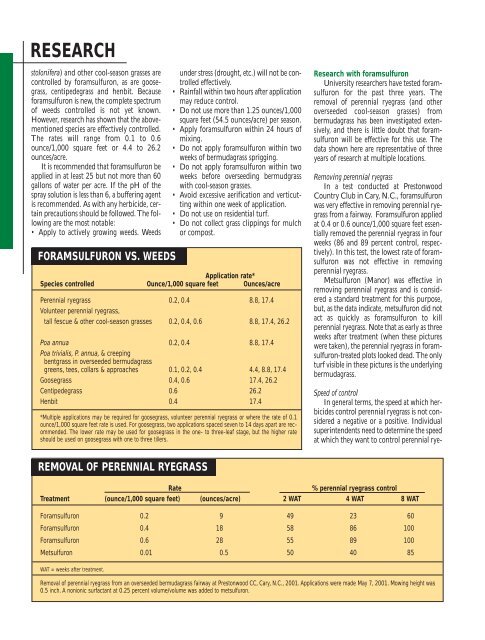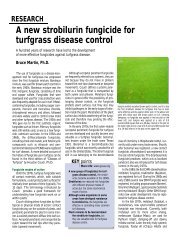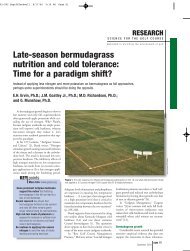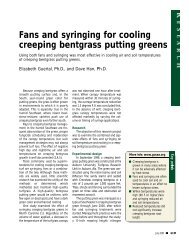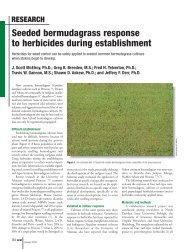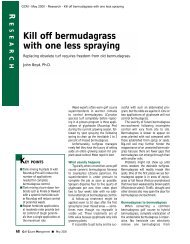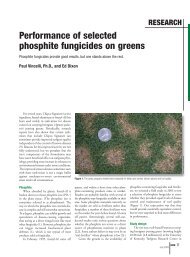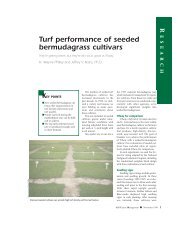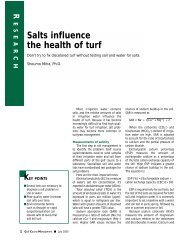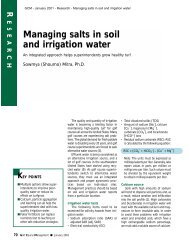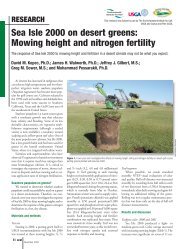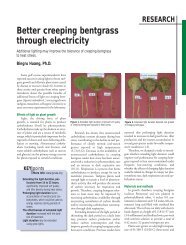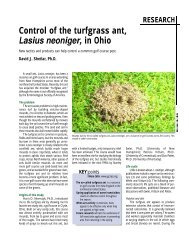A new herbicide for weeds in bermudagrass and zoysiagrass - GCSAA
A new herbicide for weeds in bermudagrass and zoysiagrass - GCSAA
A new herbicide for weeds in bermudagrass and zoysiagrass - GCSAA
Create successful ePaper yourself
Turn your PDF publications into a flip-book with our unique Google optimized e-Paper software.
RESEARCHstolonifera) <strong>and</strong> other cool-season grasses arecontrolled by <strong>for</strong>amsulfuron, as are goosegrass,centipedegrass <strong>and</strong> henbit. Because<strong>for</strong>amsulfuron is <strong>new</strong>, the complete spectrumof <strong>weeds</strong> controlled is not yet known.However, research has shown that the abovementionedspecies are effectively controlled.The rates will range from 0.1 to 0.6ounce/1,000 square feet or 4.4 to 26.2ounces/acre.It is recommended that <strong>for</strong>amsulfuron beapplied <strong>in</strong> at least 25 but not more than 60gallons of water per acre. If the pH of thespray solution is less than 6, a buffer<strong>in</strong>g agentis recommended. As with any <strong>herbicide</strong>, certa<strong>in</strong>precautions should be followed. The follow<strong>in</strong>gare the most notable:• Apply to actively grow<strong>in</strong>g <strong>weeds</strong>. WeedsFORAMSULFURON VS. WEEDSunder stress (drought, etc.) will not be controlledeffectively.• Ra<strong>in</strong>fall with<strong>in</strong> two hours after applicationmay reduce control.• Do not use more than 1.25 ounces/1,000square feet (54.5 ounces/acre) per season.• Apply <strong>for</strong>amsulfuron with<strong>in</strong> 24 hours ofmix<strong>in</strong>g.• Do not apply <strong>for</strong>amsulfuron with<strong>in</strong> twoweeks of <strong>bermudagrass</strong> sprigg<strong>in</strong>g.• Do not apply <strong>for</strong>amsulfuron with<strong>in</strong> twoweeks be<strong>for</strong>e overseed<strong>in</strong>g bermudgrasswith cool-season grasses.• Avoid excessive aerification <strong>and</strong> verticutt<strong>in</strong>gwith<strong>in</strong> one week of application.• Do not use on residential turf.• Do not collect grass clipp<strong>in</strong>gs <strong>for</strong> mulchor compost.Application rate*Species controlled Ounce/1,000 square feet Ounces/acrePerennial ryegrass 0.2, 0.4 8.8, 17.4Volunteer perennial ryegrass,tall fescue & other cool-season grasses 0.2, 0.4, 0.6 8.8, 17.4, 26.2Poa annua 0.2, 0.4 8.8, 17.4Poa trivialis, P. annua, & creep<strong>in</strong>gbentgrass <strong>in</strong> overseeded <strong>bermudagrass</strong>greens, tees, collars & approaches 0.1, 0.2, 0.4 4.4, 8.8, 17.4Goosegrass 0.4, 0.6 17.4, 26.2Centipedegrass 0.6 26.2Henbit 0.4 17.4*Multiple applications may be required <strong>for</strong> goosegrass, volunteer perennial ryegrass or where the rate of 0.1ounce/1,000 square feet rate is used. For goosegrass, two applications spaced seven to 14 days apart are recommended.The lower rate may be used <strong>for</strong> goosegrass <strong>in</strong> the one- to three-leaf stage, but the higher rateshould be used on goosegrass with one to three tillers.Research with <strong>for</strong>amsulfuronUniversity researchers have tested <strong>for</strong>amsulfuron<strong>for</strong> the past three years. Theremoval of perennial ryegrass (<strong>and</strong> otheroverseeded cool-season grasses) from<strong>bermudagrass</strong> has been <strong>in</strong>vestigated extensively,<strong>and</strong> there is little doubt that <strong>for</strong>amsulfuronwill be effective <strong>for</strong> this use. Thedata shown here are representative of threeyears of research at multiple locations.Remov<strong>in</strong>g perennial ryegrassIn a test conducted at PrestonwoodCountry Club <strong>in</strong> Cary, N.C., <strong>for</strong>amsulfuronwas very effective <strong>in</strong> remov<strong>in</strong>g perennial ryegrassfrom a fairway. Foramsulfuron appliedat 0.4 or 0.6 ounce/1,000 square feet essentiallyremoved the perennial ryegrass <strong>in</strong> fourweeks (86 <strong>and</strong> 89 percent control, respectively).In this test, the lowest rate of <strong>for</strong>amsulfuronwas not effective <strong>in</strong> remov<strong>in</strong>gperennial ryegrass.Metsulfuron (Manor) was effective <strong>in</strong>remov<strong>in</strong>g perennial ryegrass <strong>and</strong> is considereda st<strong>and</strong>ard treatment <strong>for</strong> this purpose,but, as the data <strong>in</strong>dicate, metsulfuron did notact as quickly as <strong>for</strong>amsulfuron to killperennial ryegrass. Note that as early as threeweeks after treatment (when these pictureswere taken), the perennial ryegrass <strong>in</strong> <strong>for</strong>amsulfuron-treatedplots looked dead. The onlyturf visible <strong>in</strong> these pictures is the underly<strong>in</strong>g<strong>bermudagrass</strong>.Speed of controlIn general terms, the speed at which <strong>herbicide</strong>scontrol perennial ryegrass is not considereda negative or a positive. Individualsuper<strong>in</strong>tendents need to determ<strong>in</strong>e the speedat which they want to control perennial rye-REMOVAL OF PERENNIAL RYEGRASSRate% perennial ryegrass controlTreatment (ounce/1,000 square feet) (ounces/acre) 2 WAT 4 WAT 8 WATForamsulfuron 0.2 9 49 23 60Foramsulfuron 0.4 18 58 86 100Foramsulfuron 0.6 28 55 89 100Metsulfuron 0.01 0.5 50 40 85WAT = weeks after treatment.Removal of perennial ryegrass from an overseeded <strong>bermudagrass</strong> fairway at Prestonwood CC, Cary, N.C., 2001. Applications were made May 7, 2001. Mow<strong>in</strong>g height was0.5 <strong>in</strong>ch. A nonionic surfactant at 0.25 percent volume/volume was added to metsulfuron.


